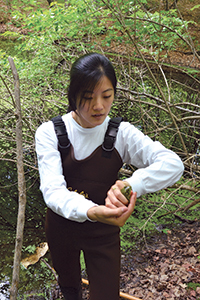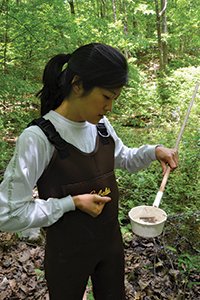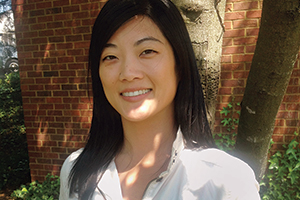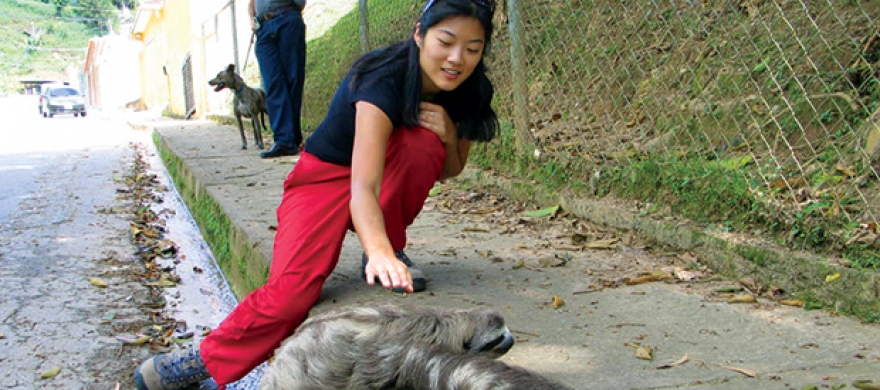Veered Science
Caught between the choice to become a veterinarian or medical doctor, a scientist contributes to both worlds as a disease ecologist.
For Barbara Han (’02), growing up in a Korean family involved meeting certain expectations. One such expectation was that she become “successful,” a word unofficially synonymous with “doctor.” So, when a preteen Han told her parents she wanted to become a veterinarian, her parents instead encouraged her to pursue a more traditional medical career—one that treats humans.
Now a distinguished disease ecologist, Han uses her medical knowledge to conduct research
on infectious zoonotic diseases—illnesses that are transmitted from animals to humans.
Han’s journey began at Pepperdine, where she immediately declared the biology major
and explored the different types of careers she could pursue with the degree. She
interned at the UCLA Medical Center in a rotating position, where she experienced
what life would be like as a medical doctor. Meanwhile, at Pepperdine she was invested
in research projects under the leadership of biology professor Lee Kats.
“It was really fortuitous that I got to have both opportunities at the same time,
because there was a stark contrast between the type of thinking and the lifestyle
that you have as a researcher versus one that you would have as a practitioner,” she
recalls. “I think that combination of events was important for my decision-making.”
In addition to the research she was doing in Malibu, Han traveled to Costa Rica in
an international program led by Kats, where she studied the biological conditions
of the country’s tropical environment. This trip proved especially fateful for Han,
as one of the professors Kats invited to attend, Andrew Blaustein, would later become
her PhD advisor at Oregon State University (OSU). During the trip Blaustein lectured on infectious diseases, including a discussion
of amphibian population declines, which not only surprised Han, but also left her
riveted. She experienced “a magical moment, when all of my worlds combined and I could
see my future.” She soon determined that her career would combine the study of both
infectious diseases and animals.
During the trip Blaustein lectured on infectious diseases, including a discussion
of amphibian population declines, which not only surprised Han, but also left her
riveted. She experienced “a magical moment, when all of my worlds combined and I could
see my future.” She soon determined that her career would combine the study of both
infectious diseases and animals.
“In many ways scientists have the same passion and enthusiasm for their studies as
an artist does for their new painting or musical composition,” says Kats. “I saw Dr.
Han get energized by discovering new things about the ecology of the small tropical
dart frog, and she hasn't exhibited any reduction in that creative energy since those
days as an undergraduate.”
After graduating from Pepperdine, Han skipped the traditional step of getting a master’s
degree and aimed straight for a PhD in zoology at OSU. As the youngest member of her
cohort, she was especially intimidated in a particular seminar where she was surrounded
by students who had graduated from some of the top universities in the country, but
when the class discussion began, she realized that her Pepperdine education had undoubtedly
prepared her for this exact setting.
“Pepperdine really emphasizes primary research, so in all the classes, you have to
read papers, think like a scientist, and dissect the problems that you encounter as
a scientist in the real world. You learn how to think critically,” Han shares.
While in the PhD program, she conducted field experiments related to infectious diseases,
specifically amphibian chytrid fungus, a then-novel fungal pathogen responsible for
causing worldwide amphibian population declines, and in some cases, extinctions. “Those
experiments involved really controlled tests, collecting animals that were uninfected
from the fields, splitting them up into experimental test and control groups, infecting
them in the lab, and measuring their behavioral responses to see what the effects
would be to this infection in the long term and in the short term,” Han explains.
“A lot of our research has been trying to catch up to how fast it’s moving across
the globe.”
She was then awarded a postdoctoral fellowship by the National Science Foundation
to receive training in mathematical modeling, a type of research approach she had
not previously explored. She worked within the realm of modeling and theoretical research
for two years at the University of Georgia, when she realized she missed working more
intimately with the type of data she obtained through the previous hands-on approaches.
Han was later granted a second fellowship, this time by the National Institutes of
Health, to continue her research on zoonotic infectious diseases. “I felt like it
touched back to my original interests, from way back when I was a child,” she says.
“There are people around the world who are racing to figure out the complexities of
some of these diseases. We’re still reacting to them rather than preventing , and that’s the focus of my work now.”
“Oftentimes, our approach is to put out the fires that pop up in the news,” she continues.
“Once the fire is out, we lose sight of the fact that we need basic information to
be able to prevent the fires from happening in the first place. We can’t just go rushing
around putting out fires for the rest of humanity. We have to do better, and I think
the way to do better is to invest in preventative, predictive solutions rather than
more fire extinguishers.” Han’s current research techniques utilize machine learning, a discipline developed
out of artificial intelligence programmed to find patterns in large comparative datasets.
She relies on these data to define the distinguishing traits possessed by the small
fraction of species that carry zoonotic diseases potentially harmful to humans.
Han’s current research techniques utilize machine learning, a discipline developed
out of artificial intelligence programmed to find patterns in large comparative datasets.
She relies on these data to define the distinguishing traits possessed by the small
fraction of species that carry zoonotic diseases potentially harmful to humans.
Han also uses machine learning algorithms to predict the wild hosts and vectors that
seed outbreaks of zoonotic diseases. She has previously relied on this approach to
research which bat species carry the Ebola virus, and to also determine which rodents
carry diseases. “Right now, we’re looking at Zika virus in mosquitos and primate species
to understand what is it about the combination of traits across these different players
in this disease game,” she explains. “What’s that magic combination of traits that
allows something to be so terrible for humans?”
Regarding Zika virus, Han mentions that the disease “doesn’t cause really terrible
symptoms in humans, so it’s easy to ignore.” She credits its substantial media coverage
to its link to microcephaly (a birth defect characterized by a very small head as
a result of abnormal brain development), as well as to increased vigilance among scientists
to learn more about its recent outbreaks. As she puts it, “The more you look for something,
the more you realize the extent of the problem.”
One challenge Han has encountered in her scientific research is that even at the height
of the information age, there exists a lack of available data on a global scale. “When
you think about the information we use to draw inferences about what allows an animal
to carry disease, that type of data is actually not available. Those data are very
sparse and expensive to collect,” she shares.
This problem is two-fold. On the one hand, Han has noticed that every time she speaks
at technology conferences and presents discussions in front of groups specializing
in machine learning, robotics, and artificial intelligence, the primary question on
everyone’s mind is: How do we develop the technology to analyze and categorize data
faster? Han believes that more time and energy must be dedicated to data collection
first rather than attempting to develop faster processing methods. She explains that
this is a sign that many people, including those who work in the science space, are
still unaware that a lot of potentially useful data has yet to be generated. The other
problem is that scientists require substantial funding in order to conduct the appropriate
studies to collect this type of data. Ultimately, Han is interested in developing a system for forecasting diseases and
quantifying the risk of a disease breaking out in a certain region. “With the increasing
frequencies of outbreaks like Zika, Ebola, and dengue, I think the public is realizing
more that this is a problem that’s not going to go away, but one that’s only going
to get worse,” she says. Han believes that her mission to solve this problem will
not be done alone, but rather as a collective effort between numerous scientists and
across multiple disciplines.
Ultimately, Han is interested in developing a system for forecasting diseases and
quantifying the risk of a disease breaking out in a certain region. “With the increasing
frequencies of outbreaks like Zika, Ebola, and dengue, I think the public is realizing
more that this is a problem that’s not going to go away, but one that’s only going
to get worse,” she says. Han believes that her mission to solve this problem will
not be done alone, but rather as a collective effort between numerous scientists and
across multiple disciplines.
Yet even amidst the most complex research topics, Han says she still applies and relies
on some of the most fundamental biological principles she learned at Pepperdine. Something
she especially appreciated about her education was its basis on the fundamentals of
biology, rather than a focus on new scientific trends that emerge every few years.
“The longer I’m in science, the more convinced I am that Pepperdine has it right,”
she reveals. “In order to be creative and innovative in biology, you have to have
the foundation right. You have to understand the basics, and you have to get trained
in them really well. That’s what Pepperdine does.”
